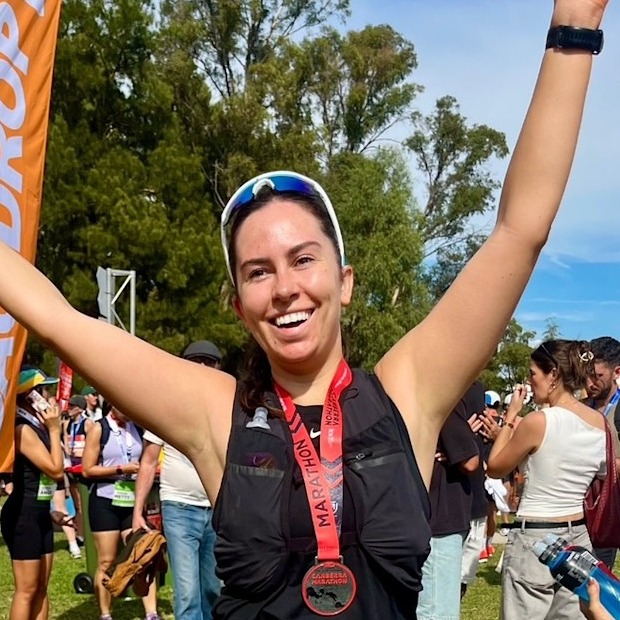
Renee Williams
Canberra Marathon
Renee's headline numbers
Renee's strategy
Fueling
Carbohydrate is the main fuel you burn when racing. Failing to fuel properly is a leading cause of underperformance in longer races.
After working with the PF&H Sports Science team ahead of her debut marathon, Renee executed a well-rehearsed and consistent fueling strategy. She took a PF 30 Gel every 40 minutes for the first 2 hours, then switched to every 30 minutes, ultimately hitting the recommended 60g/h. Having practised this plan in training, she tolerated it comfortably at race intensity despite the added nerves of her marathon debut. This steady stream of carbs helped maintain her energy from start to finish. Ahead of her next marathon, Renee is focused on improving her pre-race fueling, particularly her carb load. She felt she could optimise it in terms of the amount of carbohydrate consumed (moving closer toward the recommended 8-12g/kg/day range) as well as in the type of foods she ate (more energy dense sources) to better support her performance.
Hydration
Taking on board an appropriate amount of fluid and sodium is essential to maintaining blood volume and supporting the cardiovascular effort needed to perform on race day.
Whilst the absolute amount of sodium and fluid consumed per hour is important, it’s critical to consider these in relation to each other. This is known as 'relative sodium concentration' and it’s expressed in milligrams per litre (mg/L). How much sodium you’re taking in per litre of fluid is more important than the absolute amount taken in per hour.
Renee avoided the common mistake marathon runners make of over-drinking plain water ahead of a race, and she instead followed our recommended preloading protocol of drinking PH 1500 the night before and again on race morning, ensuring she started optimally hydrated. During the run, Renee stuck to her plan of drinking a 500ml soft flask of PH 1500 before taking an Electrolyte Capsule with each of her Gels to continue to replace a good proportion of the sodium she was losing in her sweat. However, after finishing her soft flask, Renee only took one cup of the on-course drink mix and no additional water, leaving her average fluid intake low, under 200ml/h. In the warm, humid conditions, a higher fluid intake from aid stations would’ve helped her replace more of her fluid losses and avoid low blood volume, aka dehydration, which can increase the risk of cramp. Cramping is caused by a combination of factors, one being fluid and electrolyte balance; so, taking on more water in relation to the Electrolyte Capsules she consumes would help reduce the risk of cramps in future races.
Caffeine
Beyond the Three Levers of Performance (carb, sodium and fluid), caffeine is one of only a few substances that is proven to improve performance for most endurance athletes as it can help stave off mental and physical fatigue.
Renee interspersed two PF 30 Caffeine Gels throughout her fueling strategy in an attempt to benefit from the stimulant's performance-enhancing effects. She fell just short of the recommended 3mg/kg dose for endurance exercise of 3-5 hours, so she may want to consider one additional PF 30 Caffeine Gel within the final 30 minutes pre-race to peak the level of caffeine in her system.
How Renee hit her numbers
Here's everything that Renee ate and drank on the day...
Renee's weapons of choice
Final thoughts
Renee's full stats
Data Confidence?
There is good confidence in the accuracy of the data reported. An athlete feels that the numbers closely reflect what they consumed despite a couple of estimations which may carry some degree of error. The majority of what was consumed is recorded to a high level of specificity (most volumes are known through the use of bottles brands quantities flavours). The numbers are very plausible and align with previous data recordings (if an athlete has collected data previously).